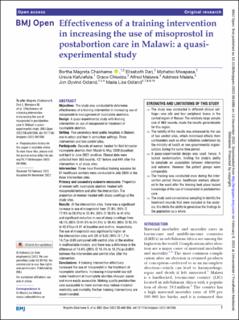| dc.contributor.author | Chakhame, Bertha Immaculate | |
| dc.contributor.author | Darj, Elisabeth | |
| dc.contributor.author | Mwapasa, Mphatso | |
| dc.contributor.author | Kafulafula, Ursula | |
| dc.contributor.author | Chiudzu, Grace | |
| dc.contributor.author | Maluwa, Alfred | |
| dc.contributor.author | Malata, Address | |
| dc.contributor.author | Odland, Jon Øyvind | |
| dc.contributor.author | Odland, Maria Lisa | |
| dc.date.accessioned | 2023-02-13T15:25:59Z | |
| dc.date.available | 2023-02-13T15:25:59Z | |
| dc.date.created | 2023-01-09T09:23:25Z | |
| dc.date.issued | 2022 | |
| dc.identifier.citation | BMJ Open. 2022, 12 (12), . | en_US |
| dc.identifier.issn | 2044-6055 | |
| dc.identifier.uri | https://hdl.handle.net/11250/3050506 | |
| dc.description.abstract | Objectives The study was conducted to determine effectiveness of a training intervention in increasing use of misoprostol in management of incomplete abortions.
Design A quasi-experimental study with training intervention on use of misoprostol in treatment of incomplete abortion.
Setting Five secondary-level public hospitals in Malawi, one in urban and four in semiurban settings. Three intervention and two control sites.
Participants Records of women treated for first-trimester incomplete abortion from March to May 2020 (baseline) and April to June 2021 (endline). Clinical data were collected from 865 records, 421 before and 444 after the intervention in all study sites.
Intervention Three-hour theoretical training sessions for 81 healthcare workers were conducted in July 2020 at the three intervention sites.
Primary and secondary outcome measures Proportion of women with incomplete abortion treated with misoprostol before and after the intervention. The proportion of women treated with sharp curettage at the study sites.
Results At the intervention sites, there was a significant increase in use of misoprostol from 22.8% (95% CI 17.9% to 28.0%) to 35.9% (95% CI 30.5% to 41.6%) and significant reduction in use of sharp curettage from 48.1% (95% CI 41.9% to 54.3%) to 39.4% (95% CI 35.3% to 42.6%) p<0.01 at baseline and endline, respectively. The use of misoprostol was significantly higher at the intervention sites with OR of 5.02 (95% CI 1.7 to 14.7) p<0.05 compared with control sites at the endline in multivariable models, and there was a difference in the difference of 14.4% ((95% CI 10.4% to 18.2%) p<0.001) between the intervention and control sites after the intervention.
Conclusions A training intervention effectively increased the use of misoprostol in the treatment of incomplete abortions. Increasing misoprostol use will make treatment of incomplete abortion cheaper, easier and more easily accessible. Making quality postabortion care accessible to more women may reduce maternal morbidity and mortality. Further training interventions are recommended. | en_US |
| dc.language.iso | eng | en_US |
| dc.publisher | BMJ Publishing Group | en_US |
| dc.rights | Attribution-NoDerivatives 4.0 Internasjonal | * |
| dc.rights.uri | http://creativecommons.org/licenses/by-nd/4.0/deed.no | * |
| dc.title | Effectiveness of a training intervention in increasing the use of misoprostol in postabortion care in Malawi: A quasi-experimental study | en_US |
| dc.title.alternative | Effectiveness of a training intervention in increasing the use of misoprostol in postabortion care in Malawi: A quasi-experimental study | en_US |
| dc.type | Peer reviewed | en_US |
| dc.type | Journal article | en_US |
| dc.description.version | publishedVersion | en_US |
| dc.source.pagenumber | 9 | en_US |
| dc.source.volume | 12 | en_US |
| dc.source.journal | BMJ Open | en_US |
| dc.source.issue | 12 | en_US |
| dc.identifier.doi | 10.1136/bmjopen-2022-061886 | |
| dc.identifier.cristin | 2102935 | |
| cristin.ispublished | true | |
| cristin.fulltext | original | |
| cristin.qualitycode | 1 | |

